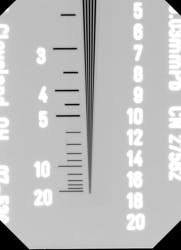Digital radiography myths
Larry Emmott, DDS
For more on this topic, go to www.dentaleconomics.com and search using the following key words: digital radiography, digital imaging, high-tech, caries detection, Dr. Larry Emmott.
Digital radiography has been around for more than 20 years, yet many dentists still resist it. Others use it but don’t understand it. I believe there are more myths or misconceptions surrounding digital radiography than any other high-tech dental system.
To help me understand the science behind some of these issues, I spoke with Doug Yoon, DDS, the founder of XDR Radiography. Dr. Yoon has more than 20 years of technical experience in the aerospace industry and more than 10 years of experience in digital radiography in both industry and as a faculty researcher in oral radiology at the UCLA School of Dentistry. There, he helped develop the first automated digital caries recognition system.
Dr. Yoon explained that there are two different types of resolution and that they measure quite different things. Spatial resolution and contrast resolution are often confused.
Spatial resolution. Line pairs per millimeter or LP/mm is a measurement of spatial resolution — that is, how small a space you can perceive. Spatial resolution is important if you want to see a very small item, such as the tip of a No. 8 endo file on a radiograph. It is not so important if you are looking for subtle changes in the density of enamel.
A line pair gauge like that shown in Fig. 1 shows five line pairs (one dark and one light) converging together into a smaller and smaller space, eventually reaching a maximum of 20 LP/mm. It is important to note the gauge only goes to 20. If radiography vendors tell you that their sensors have an LP/mm of 23 or 26, one of two things is happening: either they are mistaken or they are quoting a theoretical measurement based on pixel size.
The problem with theoretical is that it is, well, theoretical. The actual performance is always less — sometimes a lot less — that the theoretical upper limit. As a result, the only reliable measurement of LP/mm is an actual test using the gauge and the highest possible score is greater than 20. In actual testing, sensors range from as low as 8 to greater than 20 LP/mm.
Sharpening does not increase resolution. The other type of resolution is contrast resolution, the detection in subtle changes in the shade of gray. This type of resolution is important for caries detection. Sharpness and contrast are not the same thing, but when we apply them to a digital image, the result looks similar.
For dentists trained in the use of film, the sharpened image is more ... filmlike. We think it is better, higher resolution, and assume it is a better quality. But, in fact, sharpening takes away data by making the shade difference from one pixel to the next more obvious. We do see edges more clearly, but actual spatial resolution is reduced.
When we zoom in on a raw digital radiograph of a line pair per millimeter gauge (Fig. 2), we can see each line pair all the way to the tip of the scale, 20 LP/mm. But when the same image has been sharpened, the edges are indeed sharp; just look at the numbers. As we look at the actual gauge, however, we see the line pairs blur and disappear somewhere around 12 to 15 as in Fig. 3.
Many of our misunderstandings about digital radiography arise because we naturally compare it to what we are familiar with — film. However, the future is not film; it’s digital. The future is coming and it will be amazing!
Dr. Larry Emmott is the leading authority on dental high tech and one of the most entertaining speakers in dentistry. He is also a writer and consultant. To find out about his high-tech training programs, technology guides, and other services, call (602) 791-7071 or visit www.drlarryemmott.com.

